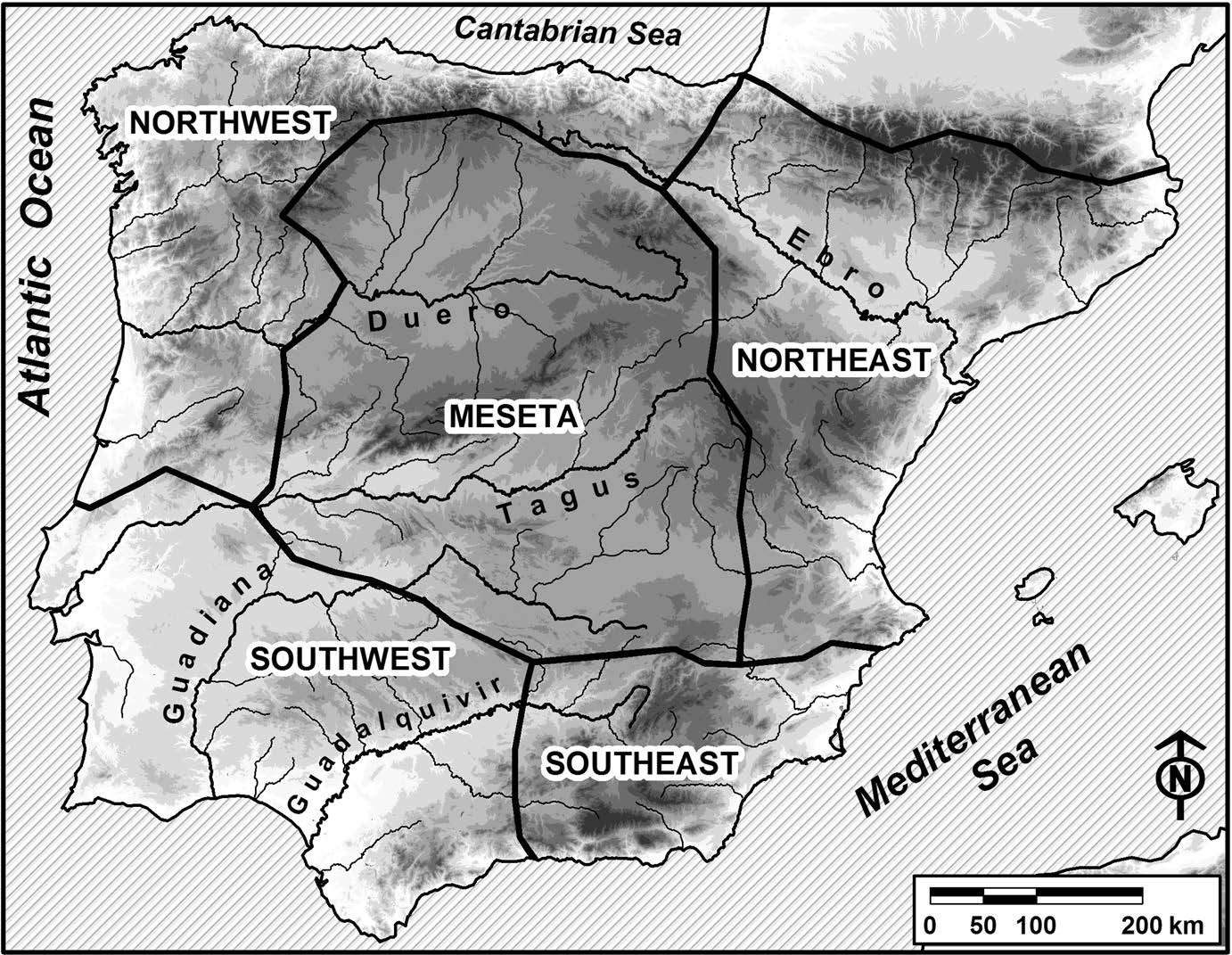New paper (behind paywall), Cultural, Demographic and Environmental Dynamics of the Copper and Early Bronze Age in Iberia (3300–1500 BC): Towards an Interregional Multiproxy Comparison at the Time of the 4.2 ky BP Event, Blanco-González, Lillios, López-Sáez, et al. J World Prehist (2018).
Abstract (emphasis mine):
This paper presents the first comprehensive pan-Iberian overview of one of the major episodes of cultural change in later prehistoric Iberia, the Copper to Bronze Age transition (c. 2400–1900 BC), and assesses its relationship to the 4.2 ky BP climatic event. It synthesizes available cultural, demographic and palaeoenvironmental evidence by region between 3300 and 1500 BC. Important variation can be discerned through this comparison. The demographic signatures of some regions, such as the Meseta and the southwest, diminished in the Early Bronze Age, while other regions, such as the southeast, display clear growth in human activities; the Atlantic areas in northern Iberia barely experienced any changes. This paper opens the door to climatic fluctuations and inter-regional demic movements within the Peninsula as plausible contributing drivers of particular historical dynamics.

Interesting excerpts summarizing key trends in the different regions:
- Between 2200 and 1900 BC, the northernmost regions (i.e. Galicia, the Cantabrian strip and the northeastern sector to the north of the Ebro valley) underwent relatively minor changes in the realms of settlement and burial practices. (…) In addition, some Atlantic areas show a marked and statistically significant fall in human activity c. 2200 BC, with a subsequent recovery c. 1600 BC, and such observations are matched by paleoenvironmental proxies and a lack of known EBA sites
- The overall impression from the Meseta is one of sharp disruption in cultural practices; these include both settlement and burial patterns, abrupt shifts in local climate conditions, and striking differences in human pressure on vegetation. However, there was also clear intra-regional variability, with remarkable internal particularities and differential tempos between the western and eastern sectors. In terms of material culture, discontinuity with the Copper Age is the main trend in the western Duero and the Tagus valleys, yet EBA communities to the north of the Central System adopted far more distinctive and therefore traceable site types (hilltops) and material repertoire. This shift was even stronger in the case of the Motillas culture at La Mancha, whose pathway seems closely tied to the Argaric area.
- Intra-regional variability is also apparent within the northeast (…) In the second millennium BC, material culture changed, long-distance exchange intensified and anthropogenic pressure increased, despite continuity in diverse realms of social practice.
- The pattern in the southwest was one of marked discontinuity with two key features: a) it follows the general decreasing trends manifest across Atlantic Iberia; and b) its temporality was clearly different from the rest of the Peninsula and apparently unrelated to the 4.2 ky BP event. Thus, a highly conspicuous and rich variety of cultural expressions in the Chalcolithic, with an early and marked peak in human activity during the Beaker phase c. 2500 BC, gave way to a sudden cultural collapse prior to the onset of the EBA
- The southeast exhibits one of the most remarkable cultural shifts in Western Europe. (…) The radical transformation in Chalcolithic materiality and ways of life could be regarded as a kind of societal collapse. The Argaric, a highly hierarchical and integrated regional polity, is the clearest example of a new scenario that emerged after the 4.2 ky BP event, yet the contributing role of environmental change and immigration from other regions remains to be fully explored.
Since R1b-DF27 lineages are widely distributed in modern western Europe, it is only logical that the recent find of its first ancient sample in Iberia has sparked the interest for Chalcolithic and Early Bronze Age Iberian cultures.
There is not much literature in English about Iberian prehistory, especially on the evolution of Bell Beaker culture. Also, most papers in Spanish on this cultural phenomenon – in my humble opinion, as a non-archaeologist – seem to be written from a merely descriptive archaeological point of view, many of them still sharing the radiocarbon-based assessment of origin and distribution of materials, instead of more complex anthropological models of cultural change and potential migrations.
Nevertheless, changes and influences in Iberian cultures are obvious regardless of the view taken on population movements (which are becoming quite clear now), and this paper seems to me a thorough review, very interesting for international researchers when interpreting ancient DNA from Iberia.
Featured image, modified from the paper: “The Bell Beaker culture in the northern Meseta: an artistic recreation of funerary ritual at Fuente Olmedo (Valladolid). Source: Garrido-Pena et al. 2011, Fig. 7.7”.
EDIT (21 MAR 2018): Interesting C14 date repository project Cronología de la Prehistoria de la Península Ibérica (read a brief description, in Spanish).
Related:
- First Iberian R1b-DF27 sample, probably from incoming East Bell Beakers
- Iberian prehistoric migrations in Genomics from Neolithic, Chalcolithic, and Bronze Age
- Patterns of genetic differentiation and the footprints of historical migrations in the Iberian Peninsula
- Analysis of R1b-DF27 haplogroups in modern populations adds new information that contrasts with ‘steppe admixture’ results
- The Tollense Valley battlefield: the North European ‘Trojan war’ that hints to western Balto-Slavic origins
- Olalde et al. and Mathieson et al. (Nature 2018): R1b-L23 dominates Bell Beaker and Yamna, R1a-M417 resurges in East-Central Europe during the Bronze Age